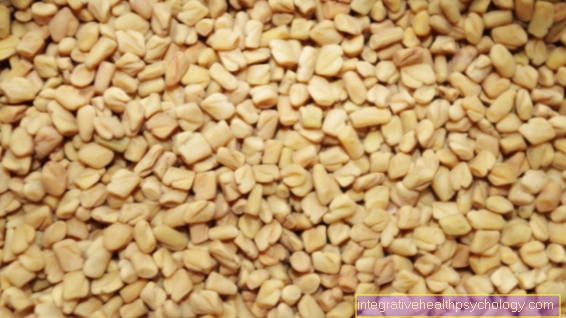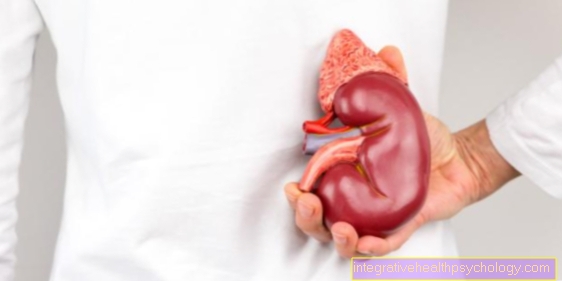Increased liver values
introduction
The liver values are defined as certain measurable parameters in the blood, which can usually be shown in the blood count (routine laboratory) when the blood is taken. If the laboratory values differ from the average standard values, this could be an indication of a malfunction or disease of the liver. The regular collection of liver values is also used to monitor the progress.

There are three liver values that are taken regularly and routinely. They are also grouped under the transaminases. They belong to the group of enzymes that are necessary for cleavage processes in the context of detoxification. The following liver values are checked routinely or if a disease is suspected:
- GPT
- GOT
- gamma GT
A supplementary examination of the so-called cholestasis parameters (bilirubin, alkaline phosphatase) can also be considered.
Read more on the topic: Functions of the liver
GPT increased
The GPT (Glutamate pyruvate transaminase) is an enzyme that is found inside the liver cells. An increase in GPT usually indicates damage to liver cells.
With a small increase in GPT, only a few liver cells have usually been damaged. If there is still no increase in GOT, which in comparison to GPT stands for more severe damage to the liver, only slight damage to the liver can be assumed.
In contrast, if the GPT was increased significantly, many liver cells were usually destroyed. In rare cases, there may be other causes, such as increased hemolysis (increased breakdown of red blood cells), for an increase in GPT.
GOT increased
The GOT (Glutamate oxaloacetate transaminase) is also an enzyme that is located inside liver cells. An increase in the GOT can also indicate damage to liver cells.
A strong increase in GOT tends to indicate that many liver cells have perished, while a weak increase indicates that only a few liver cells have been destroyed. Compared to GPT, an increase in GOT is more likely to indicate greater damage to the liver.
However, GOT occurs not only in the liver, but also in the skeletal and heart muscles. An increase in GOT can therefore also have causes other than liver damage. Among other things, a heart attack also increases the GOT. This is therefore often determined when a heart attack is suspected.
GGT increased
The GGT (Gamma glutamyl transferase) is an enzyme that is mainly found on the surface of liver cells. GGT can also be increased in liver diseases. Because of its superficial location on the liver cell, an increase in GGT usually suggests less damage to the liver.
Often the GGT is the first of the three liver values to increase in the context of increased alcohol consumption. Therefore, the GGT is also often used to control the abstinence of alcoholics who are in withdrawal therapy.
When GGT is severely increased, biliary tract diseases such as inflammation of the gallbladder (Cholecystitis) or the biliary tract (Cholangitis), be the cause.
Read more on the topic: Liver value GGT
Causes of increased liver values
Many different diagnoses can be considered as causes for elevated liver values.
An increase in liver values is very often due to increased alcohol consumption. The alcohol is broken down by the liver and converted into fat. This creates a toxic intermediate product that damages the liver cells and thus increases the liver values in the blood. The resulting fat leads to the development of fatty liver.
Patients with fatty liver are usually symptom-free. However, the liver value GGT is usually already elevated. The alcohol can also cause liver inflammation. In this alcoholic fatty liver hepatitis (ASH) the other two liver values, GPT and GOT, are also elevated.
Elevated liver values can also result from other metabolic causes. People who suffer from obesity or diabetes mellitus have an impaired lipid metabolism. In these diseases, too, fats are stored in the liver and non-alcohol-related fatty liver hepatitis (NASH) come.
Furthermore, drugs that are broken down in the liver and form toxic intermediate products can lead to an increase in liver values.
Viral diseases are other common causes of elevated liver values. The main focus is on diseases with hepatitis A, hepatitis B and hepatitis C viruses. Autoimmune diseases such as autoimmune hepatitis can also cause elevated liver values. Autoantibodies, i.e. antibodies that are directed against the body's own structures, attack the liver cells and destroy them.
Elevated liver values can also occur in the context of diseases of the biliary tract. If there are gallstones in the biliary tract (Choledocholithiasis) the bile can build up in the liver, which leads to the destruction of liver cells.
Cancer diseases can also lead to increased liver values. The liver's own cancer, the hepatocellular carcinoma, should be mentioned here. But also daughter tumors (Metastases) in the liver that originate from tumors outside the liver lead to increased liver values.
Increased liver values from alcohol
There are numerous possible causes why liver values can be elevated. The most common cause is excessive consumption of alcohol. Alcoholic people practically all have an elevation of at least one of the three liver values, if not all three. As a rule, the gamma GT value is increased with excessive alcohol consumption. It indicates that the liver has to detoxify a lot.
With one-time alcohol consumption or with regular and low alcohol consumption, the capacity of the liver is usually sufficient to render the alcohol harmless in the liver. With high amounts of alcohol, however, the liver soon reaches its limits, which is initially made clear by an increase in gamma GT. Here it can happen that gamma GT values of several hundred (e.g. 500 or 600) occur.
If the doctor finds elevated liver values in the blood, he must absolutely ask whether and, if so, how much alcohol the patient is consuming. Afterwards, an ultrasound of the liver should always be performed. This shows liver damage that has already occurred, which often leads to cirrhosis of the liver in a strong and long-term alcoholic person. Patients with cirrhosis usually have chronically elevated liver values.
As a rule, these do not decrease as much as in a healthy liver. The reason is that although liver cells can regenerate, if the liver cells have already been damaged in the past, the liver can no longer renew the cells, which causes a chronic increase in liver values.
With prolonged consumption of alcohol, the liver begins to come to the full load limits, especially since it must be remembered that even without alcohol consumption, toxins from food and the environment as well as e.g. must render the medication taken harmless. There is an increase in the transaminases GOT and GPT. These values are initially only slightly increased. However, if alcohol consumption is not consistently and sustainably restricted or stopped, these values often rise above 100.
The classic blood count of an alcoholic person is GOT, GPT and gamma GT moderately to strongly increased, with the gamma GT values providing the greatest indication of chronic alcohol consumption.
As a rule, the liver values decrease when the alcohol consumption is stopped. If you haven't drunk a drop of alcohol for several weeks, the values are usually back to normal. An exception is long-term alcohol consumption with accompanying liver damage. If the liver is already so badly damaged, it can no longer regenerate as easily, which means that the liver values no longer drop as quickly.
If chronic alcohol consumption is not completely stopped in a person with liver disease, sooner or later liver failure will occur, which inevitably leads to death. Cirrhosis of the liver is only treated symptomatically by giving medication so that the waste materials that can no longer be detoxified by the liver are excreted more quickly so that they do not cause greater damage to the body. The only treatment that is sustainable is liver transplant. Some values other than liver values play a role here, e.g. Blood coagulation values, albumin values, etc. Furthermore, the patient must be dry and it has been proven that he is not allowed to drink alcohol. If he can guarantee this, he will be put on the transplant list and will have to wait for a donor organ.
Liver values should be checked at regular intervals in alcoholic people. Recommended once or twice a year. It depends on how high the values are and how strongly they have developed.
All other patients who drink little alcohol should also have a liver test, if not as regularly. The health check-up offered by the health insurance company every 2 years is suitable for this.
Read more on the topic:
- Consequences of alcohol
- Hepatic insufficiency
- Cirrhosis of the liver
Increased liver values due to liver cirrhosis
Liver cirrhosis is the result of prolonged liver damage. The symptoms of cirrhosis of the liver, such as a feeling of pressure or fullness in the upper abdomen, fatigue, exhaustion or weight loss, are usually quite unspecific.
The main causes of liver cirrhosis are increased alcohol consumption or chronic viral hepatitis of type B or C. The liver values GPT, GOT and GGT can also be increased with liver cirrhosis. However, this is due to the damage to the liver cells as part of the underlying disease and is not a specific sign of liver cirrhosis.
To diagnose cirrhosis of the liver, an ultrasound examination of the liver can be carried out by the doctor, as well as other laboratory values such as the albumin or the Quick value can be determined.
also read: Cirrhosis of the liver
Increased liver values due to hepatitis
Hepatitis is an inflammation of the liver. As part of the inflammatory reaction, liver cells are damaged and the liver values are increased. Hepatitis can have different causes. One of the most common causes is a viral infection with the hepatitis virus of type B or C. Infection with these viruses usually occurs through contact with infectious blood or during sexual intercourse.
There is a vaccination against hepatitis B, but not against hepatitis C. In addition, hepatitis can also develop as a result of fatty liver. This then has no infectious cause. In rare cases, an autoimmune reaction can also lead to hepatitis.
Learn more at: hepatitis
Increased liver values from medication
Certain drugs can also trigger an increase in liver values. There can be various reasons for this. Medicines that can be harmful to the liver, for example in high doses or over a long period of time, can lead to an increase in liver values. In principle, this includes all drugs that are broken down by the liver, such as :
- Paracetamol which, if overdosed, can lead to liver failure
- Amiodarone is an anti-arrhythmic drug
- Cytostatics used in chemotherapy for cancer patients
- Methotrexate, used to treat rheumatism, psoriasis or Crohn's disease
- numerous antibiotics
- Clopidogrel
- Allopurinol
- Amitriptyline
Elevated liver values with cortisone therapy
Long-term use of cortisone can also lead to an increase in the liver values GOT and GPT. Cortisone is a hormone that is naturally produced in the body and used e.g. is released under stress. Normal cortisone produced and released by the adrenal gland does not increase the liver values. On the other hand, cortisone taken as a drug can lead to an increase.
The reason is that cortisone on the one hand increases blood sugar and on the other hand it can also lead to deposits in the liver through biochemical processes. The result is the formation of a fatty liver, which can then be represented in the blood by an increase in liver values GOT and GPT. However, the decisive factor is how much cortisone and how long the preparation was taken. In order to generate an increase in liver values, the high dose of cortisone must have been taken for at least a few months.
It is important that the exact cause must be determined in the event of an increase in liver values. An ultrasound examination and, if necessary, further laboratory tests are necessary for this. Hepatitis must be ruled out as well as excessive alcohol consumption.
Liver values should be checked regularly while taking cortisone.Depending on the indication and the corresponding liver values, it may be necessary to reduce the taken cortisone or gradually discontinue it.
Find out more at: Cortisone
Elevated liver values when taking pills

There are also numerous drugs that can cause an increase in liver values. One drug is the birth control pill. There are numerous patients who tolerate the pill well and who do not have an increase in liver values. In some, however, an increased GOT and GPT value can be detected.
One of the main reasons for this is that the birth control pill, like many drugs, is broken down by the liver. Sometimes the liver is so overwhelmed that it reacts with an increase in liver values. It also plays a role whether the liver is already busy. If, for example, she still has to metabolize alcohol, medication and other toxins and then the pill is also taken, the liver values can rise as a result.
It can also happen that liver values increase sharply under the contraceptive pill if particularly high-dose preparations are taken. The birth control pill is a hormone preparation that can be bought on the market in different doses. The higher the dose, the higher the risk of an increase in liver values.
If the liver function increases while taking the birth control pill, a lower-dose hormone preparation should be chosen. Regular laboratory checks should then be carried out over a period of several months to see whether the liver values have decreased again.
In the case of an increase in liver values while taking the contraceptive pill, an ultrasound of the liver should always be carried out, which should show the condition of the liver, whether the tissue is completely normal or fatty.
Stress as a cause of increased liver values
Stress is unhealthy for the human body in many ways. The liver can also be affected. In the case of long-term stress in particular, the stress hormone cortisol is increased. In high concentrations, this can be harmful to the liver.
The side effects of constant stress also have negative consequences for the liver. People who are under constant stress often eat fast food or sugary snacks to save time. They also often drink more alcohol. Stress has a negative effect on the liver, especially in conjunction with other factors.
Elevated liver values during pregnancy
During pregnancy, the rather rare pregnancy fat liver can occur. The cause is unclear. A connection with hormones is suspected.
Acute pregnancy cholestasis can also lead to an increase in liver values. The exact cause is not clear here either. Here, too, a connection with female hormones is suspected.
The dreaded HELLP syndrome also leads to an increase in liver values. It is believed that the contraction of vessels leads to damage to the red blood cells, which in turn has negative repercussions on the liver. The symptoms of a HELLP syndrome range from unspecific flu-like symptoms to a full picture with severe abdominal pain during pregnancy and severe general deterioration. In addition to the at least threefold increase in liver values, the HELLP syndrome is also characterized by a reduced number of blood platelets. Treatment is not possible except that the birth should be initiated as soon as possible. Most of the time, a caesarean section is chosen.
Read more on the topic: Complications in Pregnancy
Elevated liver values in liver cancer
Liver cancer, also known as hepatocellular carcinoma, is a malignant disease of the liver. It often occurs as a result of cirrhosis of the liver. The viral diseases hepatitis B and C can ultimately lead to liver cancer. Since liver cancer also destroys healthy liver cells, there is also an increase in liver values.
The symptoms of this form of cancer are often rather unspecific and are only noticed late. Patients often experience fatigue, weight loss, and bloating. In the process, pain in the right upper abdomen, water retention in the body and blood clotting disorders occur.
Increase in liver function tests and skin rash
In the case of a patient with elevated liver values, a complete physical examination to find the cause is on the program. If abnormalities occur in the skin area, this can always be related to the increased liver values.
For one thing, the patient may have had a skin rash and then took an appropriate drug to treat the rash. In this context, there are many drugs that raise liver values. The best-known drug in dermatology is isotrenioin, which is mainly used for acne. It can be taken in ointments or as a tablet. Both dosage forms can cause liver values to rise, although the tablet form has a stronger effect. If this is the case, the preparation should be discontinued urgently.
Many liver diseases can also cause rashes. The relationship between an increase in liver values and a rash would therefore be the other way around. These include primary sclerosing cholangitis and primary biliary cirrhosis. In any case, an ultrasound of the liver should be performed and the liver values should be monitored as a progression.
Elevated liver values without alcohol
Although the increase in liver values caused by alcohol is the most common cause, there are always patients who have high liver values and who state that they do not drink alcohol. Here it also depends on the patient survey to find out whether the lifestyle can be to blame for the increase in liver values.
Liver values increase whenever the liver has to do a lot of detoxification. This can be through alcohol but also through medication. Patients who have to take medication regularly and who take a large number of different drugs, also have an increased risk of elevated liver values.
There are also some drugs that can be specifically responsible for an increase in liver values. These include some antidepressants, such as venlafaxine or mirtazapine, or drugs that are given for skin diseases (e.g. isotreninoin).
In addition to the drug-related increase in liver values, liver inflammation can also lead to an increase in liver values. These include hepatitis A, hepatitis B and hepatitis C, which can be associated with increased liver values. If you find high liver values, but the patient denies excessive alcohol consumption or drug use, you must always assume acute hepatitis, which can lead to such an increase in liver values. Additional symptoms of hepatitis B can also occur.
There are also some more rare liver diseases that can also be associated with a non-alcohol-related increase in liver values. The so-called PSC (primary sclerosing cholangitis) and PBC (primary biliary cirrhosis) should be mentioned here.
Furthermore, fatty liver can cause an increase in liver values. Here, too, an ultrasound examination clarifies whether this is the cause.
Read more on the topic: Diet for fatty liver
Liver value increase for no reason
In not at all rare cases, there is an increase in liver values, which is determined, for example, during a routine examination and no cause can be found. In any case, it is important to rule out diagnostically urgent and sometimes dangerous causes.
Sometimes liver values are too physiologically increased. The patients then usually do not know anything about the fact, since the liver values have never been examined. It is important in this context that the liver values only slightly increased are. If, on the other hand, they are three digits, doctors in the relevant specialty should definitely be consulted in order to continue looking for the cause. In this case they would be gastroenterologists or hepatologists.
At low to moderately elevated liver values is the process control crucial. This can also be carried out by a general practitioner and, depending on the values, should be done twice a year. If there is no further increase and the values remain in this range, then further observation can be made for the time being. However, if the value continues to rise, further diagnostics must be carried out.
Symptoms of elevated liver values
Elevated liver values can be a sign of liver damage on the one hand, but also a sign of hemolysis on the other. During hemolysis, red blood cells break down, which can occur in the course of various diseases. Therefore, the symptoms are very different with elevated liver values.
Liver damage can generally lead to pain in the upper right abdomen or a feeling of pressure and fullness. This is typical of cirrhosis of the liver, for example. Nausea, vomiting or fever can also occur as part of diseases that damage the liver.
This includes, for example, hepatitis A. Further symptoms that can occur with severe liver damage are itching and yellowing of the skin, which is known as jaundice.
In cirrhosis of the liver, in which the liver values are usually increased due to the damage in the liver cells, so-called liver skin signs can also appear. These are symptoms on the skin that occur in the context of liver cirrhosis. These include, for example, so-called Spider naevi, which are small, dilated skin vessels and the so-called caput medusae. The latter appears as an expansion of superficial veins around the belly button.
Other important symptoms that can occur with elevated liver values are fatigue and decreased performance, as well as decreased well-being.
With hemolysis, the liver values can also be increased. That may sound confusing, but it is very easy to explain: Certain enzymes, the value of which is increased in the laboratory in the event of liver damage, are also found in red blood cells. Therefore, the levels may rise if a large number of red blood cells dissolve.
Symptoms of hemolysis can range from fatigue, decreased performance to pain crises and thrombosis. Because there are so many different diseases that can lead to hemolysis, it is difficult to define general symptoms.
Read more about this under: Hemolytic anemia
How can I reduce elevated liver values?
Increased liver values can be reduced by combating the cause. In the case of a liver disease, therapy must therefore always take place or a medical evaluation must be carried out. As a support, you can make sure to avoid stimulants that are harmful to the liver. This means that alcohol consumption should be avoided. This only leads to even greater liver damage and has an adverse effect on the healing process.
Further information on the topic can be found here: How can I best lower my liver values?
Drugs that are harmful to the liver should be discontinued whenever possible. However, this should be discussed with a doctor beforehand, as vital or important medication should of course not just be discontinued. However, avoid taking paracetamol if you have elevated liver values. If the pain is mild, prescription-free ibuprofen is preferred.
A balanced diet is very important, especially if you have cirrhosis of the liver. Also make sure you have an adequate protein intake in your diet.
Read more about this under: Diet for fatty liver
Lower liver values with buttermilk
Since elevated liver values can often be traced back to incorrect eating habits, such as fatty foods and excessive alcohol consumption, a change in diet is advisable. As part of a change in diet, buttermilk can have positive effects, but as a sole measure it cannot cause liver values to drop. Because of its high protein content and low fat content, buttermilk is considered very healthy.
Especially in the context of a diet, it can provide the body with the necessary proteins. It also contains important nutrients such as calcium, zinc, folic acid and many vitamins. In addition to buttermilk, numerous other foods are suitable for a liver-friendly diet. A wholesome diet also includes plenty of fresh fruit and vegetables, as well as grains and pulses.
Medicinal plants that are said to have a positive effect on the liver and biliary tract include
- dandelion
- artichoke
- Milk thistle
- daisy
- Chicory
Can you measure the liver values yourself?
Various manufacturers now offer so-called home tests for all common liver values. These are available in pharmacies or on the Internet. A test strip is held in the urine for use. A color change then shows the result.
However, it should be noted that the values are measured in the urine and not in the blood, as is the case with a doctor. A color change can also be assessed much less precisely than an exact laboratory result. Therefore it makes more sense to have the liver values tested by the doctor.
Patients aged 35 and over can have a blood test as part of the annual check-up. The check-ups taken over by the health insurance companies therefore include an examination of the liver values.





























